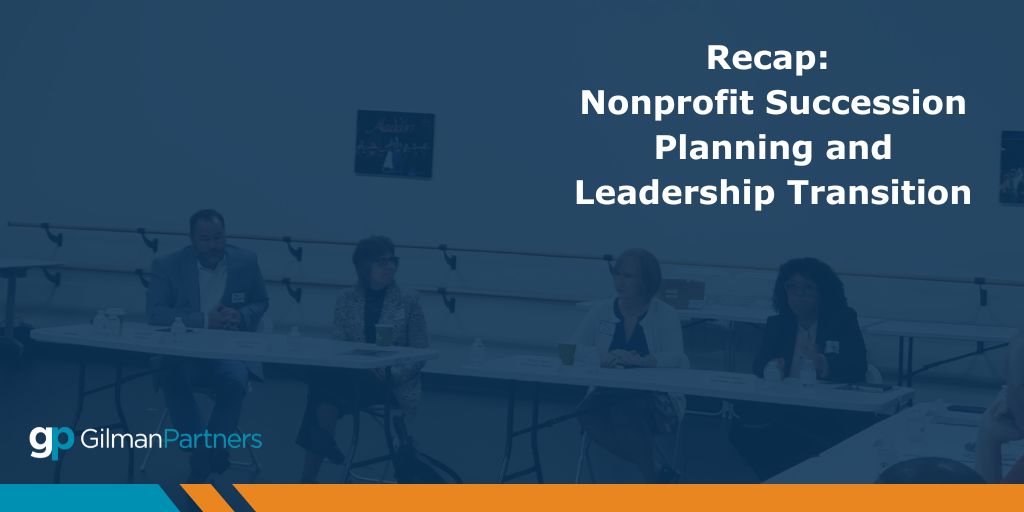Gilman Partners’ Nonprofit Leadership Practice team hosted a roundtable discussion focused on succession planning and leadership transition. Nonprofit leaders from around the Greater Cincinnati area gathered to hear experiences from the panel, which featured Tianay Amat, President & CEO of Cincinnati Works, Peggy Zink, Outgoing President & CEO of Cincinnati Works, as well as Sharon Fusco, Executive Director/CEO of Redwood, and Jeffery Hassan, Board President of Redwood. The four panelists discussed lessons learned in their leadership transitions. Here are the highlights of their discussion:
Plan the Process
- The search process for a leadership successor is not one that can be rushed. One organization on the panel completed the transition in less than a year while the other took a bit more time. Identify when the transition will occur and work backward from that marker.
- Leadership transition in the nonprofit space is complex and nuanced. The Board of any nonprofit organization serves as the strongest advocate for successful transition. Documenting the plan and timeline, and communicating those elements to the Board, is critical.
- This is an opportunity to perform an organizational assessment to examine the need for cultural change, discuss interval vs. external candidates, and to create a search committee and clarify their responsibilities.
Form a Balanced Search Committee
- The search committee should represent the diversity of the organization and the community it serves. The panelists agreed that members of varying ages, races, genders, and tenures with the organization should be chosen, which will help to maintain objectivity throughout the process. Including members of the Board is helpful because of their deep knowledge of the organization.
- Being a member of a Search Committee is a time-consuming, voluntary endeavor. Each search committee member will commit extra time dedicated to finding qualified candidates. One panelist reminded the group that each hour spent helping with the search is an hour away from their regular day-to-day responsibilities. Stay cognizant of the time commitment and remain efficient in meetings.
- The Search Committee should be formed six to nine months before the transition. Some members of the committee will be involved even after the baton is passed – essentially morphing from a “search committee” to a “transition committee” to help orient the incoming leader.
- While the Board must be highly involved in the process, it’s a good idea to limit involvement for the sake of efficiency. Avoid situations where the full Board wants to interview the candidates. Instead, give the Board reports of interview progress and invite Board members to a reception where they can meet candidates prior to the final vote.
Maintain Open Communication
- Exiting leaders must openly communicate with the Board from the very start of the process. Set up regular meetings to discuss details like timeline, successor qualifications and leadership styles, and progress to keep everyone informed.
- Community members must also be kept in the loop. This includes donors, politicians, and members of the community who would be affected by a change in the organization. One panelist stated, “When people are writing checks, they want to make sure the organization is stable and has a good future.”
- Employees should also be informed about the transition. The nonprofit world is one rooted in commitment and transparency, so it’s logical for the leader be transparent with staff about high-level details.
Select the Best Candidates
- Nonprofit work is driven by mission and values, and these must stay at the forefront of any leadership transition. Ask yourself: Is your organization a place that will attract candidates? Are the candidates’ values aligned with your mission?
- The best candidates are often the ones who ask the most questions. A panelist reminded the group that hiring great talent is a two-way street. A quality candidate should be inquisitive about many factors of the opportunity and the outgoing CEO should act as a salesperson for the role and organization.
Clarify Who is Now in Charge
- The amount of time it takes for the new leader to fully step into their new role depends on their leadership style. One panelist stated that she wanted a quick transition and a “clean break” that would reflect her as the new leader. The other panelist had the opposite experience, asking the outgoing CEO to stay connected for a few months for guidance and support.
- One panelist stated that, as the predecessor, she wanted to fully step into the background so the new leader was provided agency over their role and so the staff was clear about who was in charge. While staying connected for purposes of mentoring, she chose not to take an influential Board position.
- Host an official ceremony transitioning leadership to the new CEO will make it clear to staff and community members who is now in charge.
Nonprofit leadership transition can be a disruptive process for community members, staff, and donors. It is crucial to plan and communicate openly throughout the process of identifying and onboarding a new leader and starting as early as possible is beneficial to any organization.




